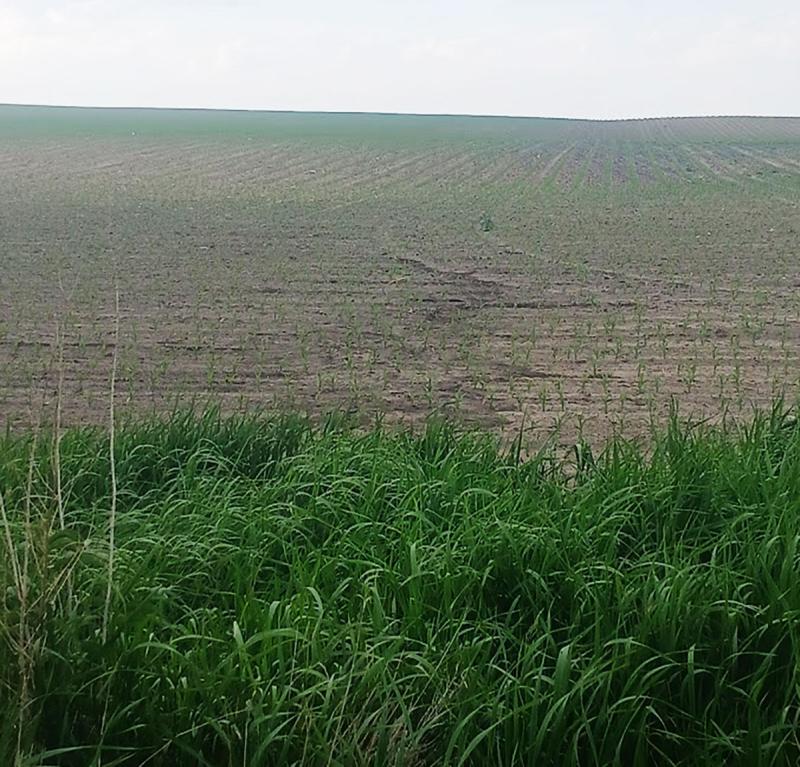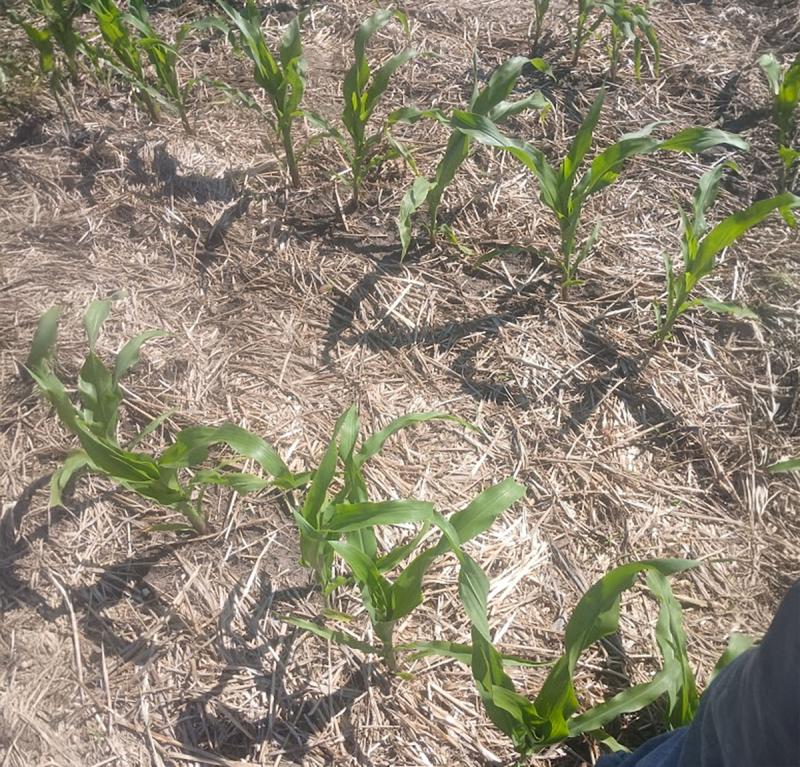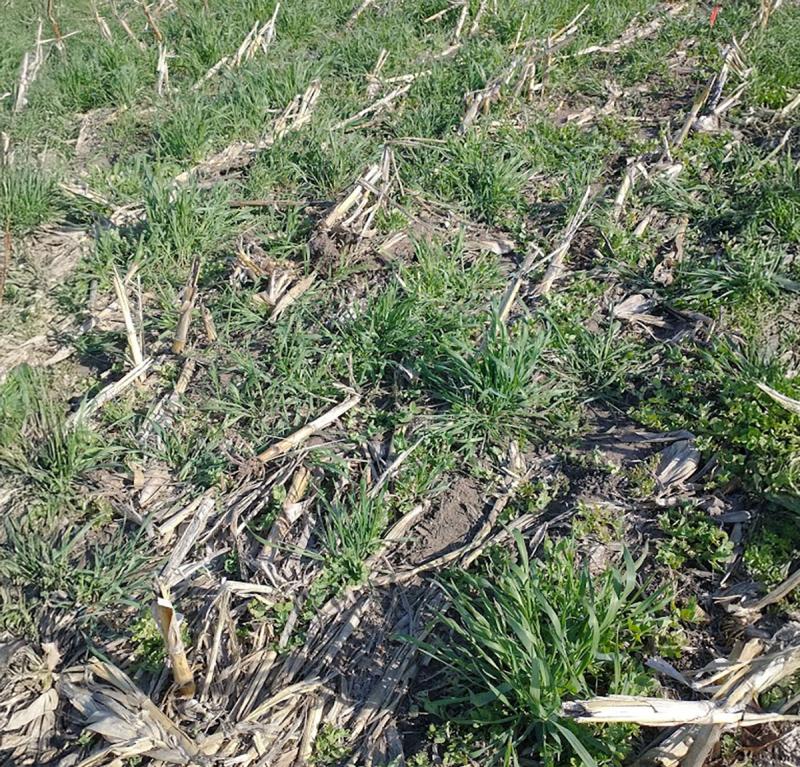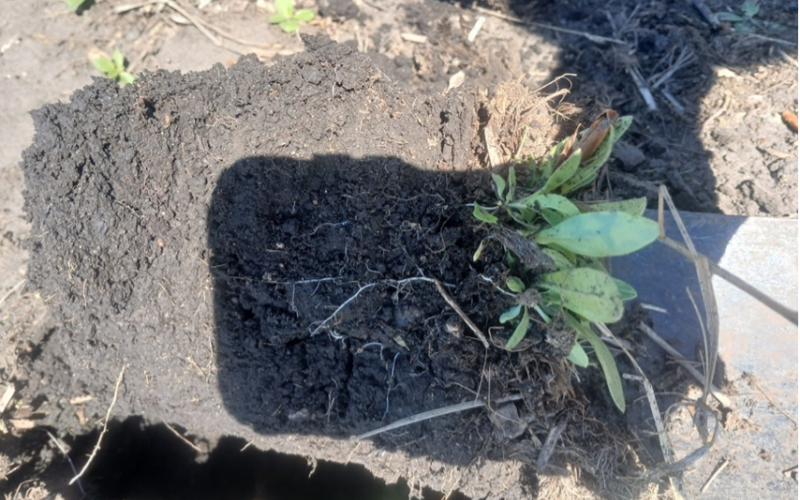Heavy rainfall events frequently occur in South Dakota. When several inches of rain are received in a short period, much of the water is not absorbed into the soil, causing erosion and standing water.
Evidence of runoff and erosion is visible in Figure 1. This event occurred in May 2025. The conventional tilled field shows sheet and rill erosion.

Soil health practices that minimize soil disturbance, increase surface cover and organic matter content, and promote continual root growth in the soil can help increase infiltration rates and reduce the destruction of soil aggregates caused by heavy rainfall events.
The benefits of improved soil health practices include increased soil organic matter content, enhanced water-holding capacity, and improved infiltration rate. These benefits lead to more water soaking into the soil profile, ensuring it is available when the growing crop needs it. For example, corn reaches its highest water requirements in July and soybeans in August. Having water stored in the soil from May and June rainfall events can help optimize yields.
Create a Management Plan
Producers who notice erosion from heavy rainfall events can develop a management plan to reduce future erosion issues.
Practices to consider include skipping fall tillage, planting cover crops after harvest, adding multiple crops to the rotation, evenly spreading residues across the field this fall, and adding organic amendments to the field.
Adopt No Tillage This Fall
Throughout this spring and summer, soil structure has formed through natural processes. One of the processes involves growing roots following the previously conducted tillage events. Between the soil structural units called aggregates, pores in the soil, began to form through wetting and drying cycles. Additionally, soil biology, including the presence of earthworms, has created pores in the soil. Tilling the soil will destroy these pores. Tilling also adds oxygen to the soil, which increases the rate that organic matter is broken down. Tillage can also reduce soil biological activity. Soil organisms play a crucial role in forming stable organic matter, creating soil structure, and cycling nutrients. Adopting no tillage will not immediately improve soil health but continuing with this practice will help improve soil health, which will increase water infiltration and soil water storage.
Leave Crop Residue in The Field
Having a cover on the soil surface is crucial for conserving soil moisture and protecting the soil. Planting crops that produce low amounts of aboveground biomass do not leave much cover on soil surface. Additionally, residues with a low carbon-to-nitrogen ratio, such as those from many broadleaf crops, rapidly break down and do not remain on the soil surface for a prolonged period. Grass crops, such as corn, sorghum, and wheat, produce high amounts of residue with a high carbon-to-nitrogen ratio that remains on the soil surface for a prolonged period. Having some residue that remains on the soil surface throughout the year helps protect the soil surface and conserve soil moisture. A picture with adequate soil cover is shown in Figure 2.

Managing residue is also important when adopting no till and for optimizing soil and water conservation. Spreading crop residue evenly across the field helps create a consistent soil cover. This can be achieved by ensuring that the combine is spreading crop residue at the same width as the combine head. Also, leave the stalks or stems as tall as possible in the field when combing the crops. This will increase snowfall capture and reduce the amount of crop residue that blows away. Additionally, skip shredding residues. Shredding the crop residue breaks it into smaller pieces, increasing its susceptibility to blowing.
Plant Cover Crops
Cover crops are another practice that can enhance the soil's ability to withstand high-intensity precipitation events. Cover crop roots create pores in the soil, allowing water to infiltrate. Additionally, cover crops contribute to the soil's carbon content, thereby increasing its organic matter. Additionally, cover crops can increase surface cover, which helps protect the soil surface. Numerous opportunities exist to incorporate cover crops into South Dakota's cropping systems. The best chance is following the harvest of a small grain or corn and sorghum fields harvested for silage. The cover crops should be planted as soon as possible after harvest to allow the longest possible time for the cover crop to grow prior to being terminated by frost. Planting a mixture of species, including both warm- and cool-season species, will optimize biomass production and benefit soil health. Another good opportunity to incorporate cover crops into the cropping system is to plant rye after corn, followed by soybeans. Most studies in the Midwest have found no penalty to soybean yield when planting into a rye cover crop (Silva et al., 2024). Rye can also be a good cover crop to plant following harvest of other crops, as long as you are not growing certified winter wheat seed in the near future. A rye cover crop growing in corn residue is shown in Figure 3.

Plant a Multiple Crop Rotation
Certain crops produce more above-ground biomass and have a higher carbon-to-nitrogen ratio. A higher carbon-to-nitrogen ratio in crop residue helps it remain on the soil surface for a longer period. Keeping a cover on the soil surface helps maintain soil structure and protect the soil from erosion. Adding a small grain crop to the crop rotation and planting low-residue and low-carbon-nitrogen ratio crops, such as soybeans, every 3 or 4 years can help increase armor on the soil surface and improve soil health. Additionally, cropping systems that incorporate small grains with corn and soybeans have been shown to have better soil health compared to cropping systems that contain only corn and soybeans (Chahal et al., 2021; Karlen et al., 2006). Additionally, incorporating small grains into the crop rotation can provide a valuable opportunity to integrate cover crops into the cropping system. Having cropping systems that improve soil health and peak water use at different times of the year can enhance water use efficiency and ensure that at least some of the crops being grown succeed.
Add Organic Amendments to the Soil
Another soil health principle is to incorporate livestock into cropping systems. Grazing cover crops and crop residues provides an opportunity to integrate livestock into annual cropping systems. When livestock graze on a field, they return most of the carbon and nutrients from the plants they eat back to the soil. This is a good way to provide feed for livestock without removing all the biomass from the land. When grazing cover crops and residues, the amount of cover remaining on the surface should be monitored to ensure that sufficient cover is left on the soil surface.
Also, livestock manure from other operations can be applied to the field. Manures have a carbon-to-nitrogen ratio closer to what soil microbes prefer, which is 24:1. The addition of livestock grazing on annual crop ground or the application of manures can increase soil microbial activity and organic matter. The addition is expected to enhance soil water storage and infiltration. Grazing livestock or spreading manure when the soil is too wet can lead to soil compaction. Other organic amendments that could be applied to the soil include compost or biochar which also can increase soil water holding capacity and infiltration.
Summary
A good strategy to improve water infiltration into the soil and increase subsequent storage is to take a proactive approach rather than a reactive one. Building soil health takes time, and using these practices for only a year may not yield a significant improvement in soil health, water infiltration, and storage.
Achieving significant improvements in soil health and water infiltration through these practices, preferably in combination, will result in a reduction in the amount of water that runs off and increases the amount of water stored in the soil. Having improved water infiltration and storage and reduced runoff can lead to more sustainable agricultural production while reducing the loss of soil and nutrients to surface waters.
References
- Chahal, I., Hooker, D. C., Deen, B., Janovicek, K., & Van Eerd, L. L. (2021). Long-term effects of crop rotation, tillage, and fertilizer nitrogen on soil health indicators and crop productivity in a temperate climate. Soil and Tillage Research, 213, 105121.
- Karlen, D. L., Hurley, E. G., Andrews, S. S., Cambardella, C. A., Meek, D. W., Duffy, M. D., & Mallarino, A. P. (2006). Crop rotation effects on soil quality at three northern corn/soybean belt locations. Agronomy journal, 98(3), 484-495.
- Silva, T.S., Mourtzinis, S., McMechan, A.J., Carmona, G.I., Potter, B.D., Tilmon, K.J., Hesler, L.S., Seiter, N.J., Wright, R., Osborne, S.L. and Hunt, T.E., 2024. Cereal rye cover crop termination at or before soybean planting has minimal effect on soybean yield across the midwestern US. Field Crops Research, 312, p.109393.


